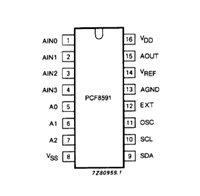FUNCTIONAL DESCRIPTION
Device Erasure
VPP = 12.75 V ± 0.25 V and PGM# LOW and OE#
HIGH will program that particular device. A high-level
CE# input inhibits the other devices from being pro-
grammed.
In order to clear all locations of their programmed con-
tents, the device must be exposed to an ultraviolet light
source. A dosage of 15 W seconds/cm2 is required to
completely erase the device. This dosage can be ob-
tained by exposure to an ultraviolet lamp—wavelength
of 2537 Å—with intensity of 12,000 µW/cm2 for 15 to 20
minutes. The device should be directly under and about
one inch from the source, and all filters should be re-
moved from the UV light source prior to erasure.
Program Verify
A verification should be performed on the programmed
bits to determine that they were correctly programmed.
The verify should be performed with OE# and CE#, at
VIL, PGM# at VIH, and VPP between 12.5 V and 13.0 V.
Autoselect Mode
Note that all UV erasable devices will erase with light
sources having wavelengths shorter than 4000 Å, such
as fluorescent light and sunlight. Although the erasure
process happens over a much longer time period, ex-
posure to any light source should be prevented for
maximum system reliability. Simply cover the package
window with an opaque label or substance.
The autoselect mode provides manufacturer and de-
vice identification through identifier codes on DQ0–
DQ7. This mode is primarily intended for programming
equipment to automatically match a device to be pro-
grammed with its corresponding programming algo-
rithm. This mode is functional in the 25°C ± 5°C
ambient temperature range that is required when pro-
gramming the device.
Device Programming
Upon delivery, or after each erasure, the device has
all of its bits in the “ONE”, or HIGH state. “ZEROs” are
loaded into the device through the programming pro-
cedure.
To activate this mode, the programming equipment
must force VH on address line A9. Two identifier bytes
may then be sequenced from the device outputs by tog-
gling address line A0 from VIL to VIH (that is, changing
the address from 00h to 01h). All other address lines
must be held at VIL during the autoselect mode.
The device enters the programming mode when 12.75
V ± 0.25 V is applied to the VPP pin, and CE# and
PGM# are at VIL and OE# is at VIH.
Byte 0 (A0 = VIL) represents the manufacturer code,
and Byte 1 (A0 = VIH), the device identifier code. Both
codes have odd parity, with DQ7 as the parity bit.
For programming, the data to be programmed is ap-
plied 8 bits in parallel to the data pins.
The flowchart in the Programming section of the
EPROM Products Data Book (Section 5, Figure 5-1)
shows AMD’s Flashrite algorithm. The Flashrite algo-
rithm reduces programming time by using a 100 µs pro-
gramming pulse and by giving each address only as
many pulses to reliably program the data. After each
pulse is applied to a given address, the data in that ad-
dress is verified. If the data does not verify, additional
pulses are given until it verifies or the maximum pulses
allowed is reached. This process is repeated while se-
quencing through each address of the device. This part
of the algorithm is done at VCC = 6.25 V to assure that
each EPROM bit is programmed to a sufficiently high
threshold voltage. After the final address is completed,
Read Mode
To obtain data at the device outputs, Chip Enable (CE#)
and Output Enable (OE#) must be driven low. CE# con-
trols the power to the device and is typically used to se-
lect the device. OE# enables the device to output data,
independent of device selection. Addresses must be
stable for at least tACC–tOE. Refer to the Switching
Waveforms section for the timing diagram.
Standby Mode
The device enters the CMOS standby mode when CE#
is at VCC ± 0.3 V. Maximum VCC current is reduced to
100 µA. The device enters the TTL-standby mode
when CE# is at VIH. Maximum VCC current is reduced
to 1.0 mA. When in either standby mode, the device
places its outputs in a high-impedance state, indepen-
dent of the OE# input.
the entire EPROM memory is verified at VCC = VPP
5.25 V.
=
Please refer to Section 5 of the EPROM Products Data
Book for additional programming information and spec-
ifications.
Output OR-Tieing
To accommodate multiple memory connections, a
two-line control function provides:
Program Inhibit
Programming different data to multiple devices in par-
allel is easily accomplished. Except for CE#, all like in-
puts of the devices may be common. A TTL low-level
program pulse applied to one device’s CE# input with
■ Low memory power dissipation, and
■ Assurance that output bus contention will not occur.
Am27C010
5






 STM32F030C6芯片介绍:主要参数分析、引脚配置说明、功耗及封装
STM32F030C6芯片介绍:主要参数分析、引脚配置说明、功耗及封装

 PCF8591数据手册解读:参数、引脚说明
PCF8591数据手册解读:参数、引脚说明

 一文带你了解ss8050参数、引脚配置、应用指南
一文带你了解ss8050参数、引脚配置、应用指南

 深入解析AD7606高性能多通道模数转换器:资料手册参数分析
深入解析AD7606高性能多通道模数转换器:资料手册参数分析
